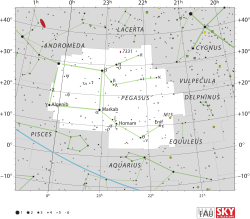Fi Pegasi
| Fi Pegasi | |
 | |
| Observationsdata Epok: J2000.0 | |
|---|---|
| Stjärnbild | Pegasus |
| Rektascension | 23t 52m 29,28762s[1] |
| Deklination | +19° 07′ 13,0218″[2] |
| Skenbar magnitud () | +5,107[3](+5,11-5,17 (p))[4] |
| Stjärntyp | |
| Spektraltyp | M2.5 IIIb[5] |
| U–B | +1,878[3] |
| B–V | 1,587 ± 0,006[6] |
| Variabeltyp | Halvregelbunden variabel (SRB:)[4] |
| Astrometri | |
| Radialhastighet () | -7,75 ± 0,08[7] km/s |
| Egenrörelse (µ) | RA: -7,27 ± 0,21[1] mas/år Dek.: -35,40 ± 0,15[1] mas/år |
| Parallax () | 7,05 ± 0,27[1] |
| Avstånd | 460 ± 20 lå (142 ± 5 pc) |
| Absolut magnitud () | -0,70[8] |
| Detaljer | |
| Radie | 29,32[8] R☉ |
| Luminositet | 609,39[8] L☉ |
| Temperatur | 3 827[8] K |
| Andra beteckningar | |
| 81 Pegasi, GEN# +1.00223768, N30 5232, SRS 30898, GSC 01725-02097, NSV 14735, TYC 1725-2097-1, HD 223768, PLX 5771, UBV 20490, AG+18 2405, HIC 117718, PLX 5771.00, UBV M 27299, BD+18 5231, HIP 117718, PMC 90-93 634, YZ 18 9719, DO 22512, HR 9036, PPM 142928, DS98 345, FK5 898, IRAS 23499+1850, RAFGL 3166, GC 33119, IRC +20555, SAO 108878, GCRV 14939, 2MASS J23522929+1907128, SKY# 45055[2] | |
Fi Pegasi (φ Pegasi, förkortat Phi Peg, φ Peg), som är stjärnans Bayer-beteckning, är en ensam stjärna i den östra delen av stjärnbilden Pegasus. Den har en genomsnittlig skenbar magnitud på +5,107[3] och är synlig för blotta ögat där ljusföroreningar ej förekommer. Baserat på parallaxmätningar i Hipparcos-uppdraget på ca 7,1[1] mas beräknas den befinna sig på ca 460 ljusårs (142 parsek) avstånd från solen. På det beräknade avståndet minskar stjärnans skenbara magnitud genom en skymningsfaktor med 0,15 enheter på grund av interstellärt stoft.[7]
Egenskaper
[redigera | redigera wikitext]Fi Pegasi är en orange till röd jättestjärna av spektralklass M2.5 IIIb.[5] Den har en radie som är ca 29[8] gånger större än solens och utsänder ca 610[8] gånger mera energi än solen från dess fotosfär vid en effektiv temperatur på ca 3 800 K.[8]
Fi Pegasi är en halvregelbunden variabel av SRB-typ[4]. Den har en skenbar magnitud som varierar mellan 5,11 och 5,17.[4] Fotometriska mätningar inom Hipparkos-uppdraget ger en amplitudvariation på 0,0148 i magnitud med en frekvens av 11,4 cykler per dygn.[9]
Se även
[redigera | redigera wikitext]Referenser
[redigera | redigera wikitext]- Den här artikeln är helt eller delvis baserad på material från engelskspråkiga Wikipedia, Phi Pegasi, 25 april 2019.
Noter
[redigera | redigera wikitext]- ^ [a b c d e] van Leeuwen, F. (2007), "Validation of the new Hipparcos reduction", Astronomy and Astrophysics, 474 (2): 653–664, arXiv:0708.1752, Bibcode:2007A&A...474..653V, doi:10.1051/0004-6361:20078357.
- ^ [a b] ”Basic data: V*Phi Peg – Long-period variable star” (på engelska). Centre de Données astronomiques de Strasbourg. http://simbad.u-strasbg.fr/simbad/sim-basic?Ident=Phi+Peg&submit=SIMBAD+search. Läst 9 juni 2017.
- ^ [a b c] Gutierrez-Moreno, Adelina; et al. (1966), A System of photometric standards, 1, Publicaciones Universidad de Chile, Department de Astronomy, pp. 1–17, Bibcode:1966PDAUC...1....1G.
- ^ [a b c d] ”Phi Peg” (på engelska). The International Variable Star Index. AAVSO – American Association of Variable Star Observers. http://www.aavso.org/vsx/index.php?view=detail.top&oid=25523. Läst 9 juni 2017.
- ^ [a b] Eggleton, P. P.; Tokovinin, A. A. (September 2008), "A catalogue of multiplicity among bright stellar systems", Monthly Notices of the Royal Astronomical Society, 389 (2): 869–879, arXiv:0806.2878, Bibcode:2008MNRAS.389..869E, doi:10.1111/j.1365-2966.2008.13596.x.
- ^ van Leeuwen (2007). ”Hipparcos, the New Reduction” (på engelska). http://vizier.u-strasbg.fr/viz-bin/VizieR-5?-out.add=.&-source=I/311/hip2&HIP=117718. Läst 9 juni 2017.
- ^ [a b] Famaey, B.; et al. (January 2005), "Local kinematics of K and M giants from CORAVEL/Hipparcos/Tycho-2 data. Revisiting the concept of superclusters", Astronomy and Astrophysics, 430: 165–186, arXiv:astro-ph/0409579, Bibcode:2005A&A...430..165F, doi:10.1051/0004-6361:20041272.
- ^ [a b c d e f g] https://www.universeguide.com/star/phipegasi. Hämtad 2019-04-25.
- ^ Koen, Chris; Eyer, Laurent (2002), "New periodic variables from the Hipparcos epoch photometry", Monthly Notices of the Royal Astronomical Society, 331: 45, arXiv:astro-ph/0112194,Bibcode:2002MNRAS.331...45K, doi:10.1046/j.1365-8711.2002.05150.x.





